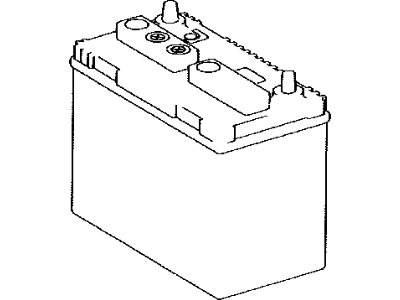This part fits the vehicle you selected:
My Vehicle: JTEZU14R870096833 2007 Toyota 4Runner 6 Cyl 4.0L DOHC EFI; SR5; Automatic Transmission; 5-Speed Automatic Transmission; GRN210L-GKAGKA
Change VehicleThe vehicle options this part fits:
- Production Date: 08/2005-
- Fitting Vehicle Options: 1GRFE, 2UZFE.. GRN21#, UZN21#
Toyota 28800-66021 Battery
1996-2021 Toyota 2880066021

- Part DescriptionBattery
- 105D31L,BATTERY-105D31L(USA & CANADA),MATSUSHITA
- Part Name Code28800
- ManufacturerToyota
This part fits the vehicle you selected:
JTEZU14R870096833 2007 Toyota 4Runner 6 Cyl 4.0L DOHC EFI; SR5; Automatic Transmission; 5-Speed Automatic Transmission; GRN210L-GKAGKA
The vehicle options this part fits:
- Production Date: 08/2005-
- Fitting Vehicle Options: 1GRFE, 2UZFE.. GRN21#, UZN21#
$1157.59 MSRP: $1703.97 1
You Save: $546.38 (33%)
Ships in 1-3 Business Days
Product Specifications
| Brand | Genuine Toyota |
| Part Name Code | 28800 |
| Manufacturer Part Number | 28800-66021 |
| Part Description | Battery |
| Item Weight | 40.00 Pounds |
| Condition | New |
| Fitment Type | Direct Replacement |
| Manufacturer | Toyota |
| SKU | 28800-66021 |
| Warranty | This genuine Toyota part is guaranteed by Toyota's factory warranty. |
| Shipping & Return | Shipping Policy Return Policy |
Warning: California’s Proposition 65
Customer Questions & Answers
- Q:I just want to confirm I'm purchasing a correct part before placing an order Posted by ToyotaPartsDeal Specialist
- A:You can Select Your Vehicle to check if 28800-66021 fits your vehicle.Posted by ToyotaPartsDeal Specialist
- Q:What are the safety precautions and steps for maintaining a Toyota 4Runner's battery? Posted by Customer
- A:To ensure reliable and quick starts, a routine preventive maintenance program for your vehicle's battery is crucial, but it's essential to have the necessary safety equipment, including a face shield or safety goggles, baking soda, petroleum jelly, battery post and cable cleaner, treated felt washers, puller, and rubber gloves, when working around the battery. Safety precautions must be observed during battery maintenance, such as turning off the engine and all accessories, disconnecting the negative terminal cable, and avoiding sparks, smoking, or open flames near the battery due to the flammable and explosive nature of hydrogen gas produced by the battery. Moreover, handle the corrosive sulfuric acid in the battery's electrolyte with care, wearing protective safety glasses, and ensuring it doesn't contact your skin, eyes, or clothing. Children should be kept away from the battery. Inspect the battery for external damage, including corroded or loose connections, damaged rubber protectors on the terminals, cracks in the case, loose hold-down clamps, and cable issues. Corroded terminals require battery removal for cleaning, which involves loosening cable clamps with a wrench, removing the ground cable first, cleaning the clamps, terminals, and battery top with a warm water and baking soda solution (while wearing safety goggles and gloves), and using a terminal cleaner for extensively corroded terminals. Ensure the battery tray is in good condition, hold-down clamp bolts are tight, and no parts are left in the tray when reinstalling the battery. Any metal parts damaged by corrosion should be covered with a zinc-based primer and painted. Charging the battery is best done with it removed from the vehicle to prevent paint damage from escaping gas. Slow-rate charging using a one or two-amp trickle charger is recommended, as it's safe and less strenuous on the battery. Higher amperage chargers can be used but should not exceed 1/10th of the battery's amp/hour rating. Rapid boost charges should be reserved for emergencies. A trickle charger typically takes 12 to 16 hours to charge a battery. During charging, ensure cell caps (if present) are covered with a cloth to prevent electrolyte spattering, disconnect the negative cable, connect the charger cables (positive to positive, negative to negative), and set the charger to 12 volts if applicable. For higher-amperage chargers, monitor the battery for overheating. If the battery has removable cell caps, measure specific gravity with a hydrometer every hour during the last few hours of charging, considering it fully charged when specific gravity readings remain stable for two hours and electrolyte bubbles freely. Sealed batteries may have built-in hydrometers or require a voltmeter reading of 12.6 volts or higher post-surface charge removal to indicate a full charge.Posted by ToyotaPartsDeal Specialist
If you have any questions about this product, please don't hesitate to ask us. We will be happy to help you!
Why choose Toyota Parts Deal
- Dedicated Service
Your complete satisfaction is our #1 goal
- Lowest Prices
Best deals on genuine OE parts from dealerships
- Fast Delivery
Orders are processed and delivered promptly

